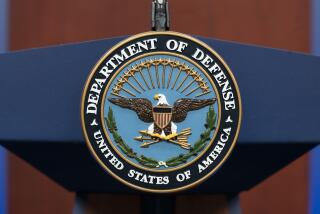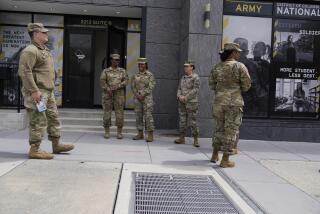U.S. Afghan forces to grow
- Share via
WASHINGTON — President Obama ordered his first major deployment of U.S. combat troops Tuesday, authorizing 17,000 additional soldiers and Marines for Afghanistan in what he described as an urgent bid to stabilize a deteriorating and neglected country.
The deployment will double the number of American combat brigades in the nation at a time of tension with Afghanistan’s weak government over civilian casualties of the campaign against the increasingly bold Taliban, and concern over neighboring Pakistan’s ability to fight Islamic militants based there.
In a statement announcing the troop increase, Obama directed veiled criticism at the Bush administration, noting that a request from Army Gen. David D. McKiernan, the top U.S. commander in Afghanistan, had been pending for months.
“This increase is necessary to stabilize a deteriorating situation in Afghanistan, which has not received the strategic attention, direction and resources it urgently requires,” Obama said.
In undertaking the “solemn duty” to dispatch troops to war, Obama also delved into one of the main issues of his long presidential campaign. While denouncing the Iraq war as a mistake, Obama repeatedly pledged to refocus on Afghanistan.
Though fulfilling requests submitted by U.S. commanders, Tuesday’s order leaves crucial questions of strategy and tactics unanswered until a strategy review is completed in April. In a hint that his strategy would include more than military power, Obama said he would “employ all elements” of U.S. government resources to meet achievable goals, with help from U.S. allies.
In dispatching the troops for duty in Afghanistan, Obama also expressed concern about the threat from extremists elsewhere in the region, including in havens in Pakistan.
Debate has raged for months about the possible effectiveness in Afghanistan of a “surge,” the term used for the 2007 troop increase in Iraq that has been credited with helping stabilize that country.
Military officials have been careful not to use that terminology for the current increase in Afghanistan, arguing that additional troops could be needed there for years. But senior Defense officials said that they believe they must quickly demonstrate results, roll back Taliban advances and bring some measure of stability.
“These troops are going to help us counter Taliban territorial advances, deny safe havens and create security for Afghan civilians,” said a senior Obama administration official, speaking on the condition of anonymity because he was not authorized to speak publicly.
The official also indicated that more U.S. special operations forces would be deployed in the Central Asian nation. Their role will be principally “to help train Afghans,” the official said, but he added that “they’re going to be involved in supplementing and supporting ongoing activities.”
There are 38,000 U.S. troops in Afghanistan, including three combat brigades and noncombat troops. Their numbers were bolstered by the recent arrival of the 3rd Brigade Combat Team of the Army’s 10th Mountain Division, which has begun operating in eastern Afghanistan.
The upcoming deployment will total 17,000 troops, the senior administration official said. A force of 8,000 Marines, consisting of the 2nd Marine Expeditionary Brigade from Camp Lejeune, N.C., will reach southern Afghanistan this spring. The Marine unit contains infantrymen, helicopters, fighter planes and other support elements.
In the summer, 4,000 soldiers from the 5th Stryker Brigade, part of the Army’s 2nd Infantry Division at Ft. Lewis, Wash., will follow, along with 5,000 support troops.
Commanders in Afghanistan have sought additional combat brigades, aviation units and other support, representing an increase of more than 20,000 troops.
The official said that all the troops would be in place before the presidential election Aug. 20, the first in five years.
In Senate testimony last week, Director of National Intelligence Dennis C. Blair said that insurgents probably would make a concerted effort to disrupt the balloting.
The Army brigade will be the first in Afghanistan equipped with Strykers, an armored wheeled vehicle. Strykers were judged to be capable in urban settings in Iraq, though Pentagon planners have debated whether they would be effective in the more difficult terrain of Afghanistan.
A senior Army official said Tuesday that the Stryker brigade would be able to help retake roads from Taliban and other militants who have been growing increasingly brazen in setting up roadblocks and bombs on Afghanistan’s highways. The senior Army official spoke on condition of anonymity when discussing troop plans.
Obama said his plans to reduce the U.S. force in Iraq would give him the “flexibility” to build up the force in Afghanistan. There are about 146,000 U.S. troops in Iraq. Obama has not detailed plans for reducing the force in Iraq, but has said he wants combat units out of the country by the end of next year. Military officials have said that troop increases in Afghanistan depend on reductions in Iraq.
“All we are doing is moving demand from Iraq to Afghanistan,” the official said. “This sustains and, to some degree, increases the demands on soldiers.”
The troop escalation comes with some risks, including the possibility of a further increase in civilian casualties. Afghan President Hamid Karzai has repeatedly demanded that the U.S. and its allies take more care to avoid killing or wounding civilians, and U.S. officials acknowledge that accidentally causing civilian casualties hurts the war effort.
A United Nations report issued Tuesday said the number of civilians killed had risen almost 40% last year, growing to 2,118 from 1,523 in 2007.
More than half of the deaths, 1,160, were blamed on militants, but 828 were attributed to Afghan and international forces. The cause of the other 130 deaths could not be determined. Airstrikes accounted for 552 of the deaths, the U.N. said.
--
Times staff writer Peter Nicholas in Denver contributed to this report.
More to Read
Sign up for Essential California
The most important California stories and recommendations in your inbox every morning.
You may occasionally receive promotional content from the Los Angeles Times.










